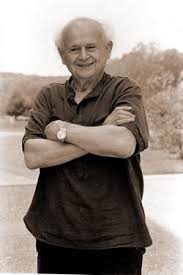The Feldenkrais Method®
The Feldenkrais Method® is an extraordinary approach to learning through movement. Developed in the 1940s and ’50s by Moshe Feldenkrais, an engineer and physicist – as well as the first westerner to receive a black belt in Judo – the method is based on principles of human development, neuroscience, and body mechanics. Feldenkrais was a keen observer and student of human psychology, development, and movement, and his method was born of his own necessity: Faced with limited options to repair an old knee injury, he began to explore ways of moving that would reduce his pain and improve his mobility. Thus, the hundreds of lessons that he developed over decades of teaching are designed to help us grow our awareness of how we use ourselves, unwind patterns of holding and acting/reacting, and make available new options for the ways we move, think, and feel.
The Feldenkrais Method® is taught in two formats: group lessons known as Awareness Through Movement®, and individual lessons called Functional Integration®. In group lessons, students are lead through a series of movements – mostly done lying or sitting on the floor – by verbal instruction. As students interpret the instruction and perform the movements, they develop awareness of their habits and tendencies, and discover new options for moving – as well as thinking and feeling. The intention is the same for individual lessons, but they are one-on-one sessions tailored to meet the individual student’s needs. The student is usually lying or sitting on a low table (fully clothed), and the practitioner uses gentle hands-on communication as well as verbal instruction to help guide awareness and learning.
“The lessons are designed to improve ability, that is, to expand the boundaries of the possible: to turn the impossible into the possible, the difficult into the easy, and the easy into the pleasant.”
— Moshe Feldenkrais
Feldenkrais lessons are ideal for anyone who:
- experiences discomfort or limitations in movement as a result of injury, structural characteristics, or postural tendencies
- would like to improve their performance and/or enjoyment of an activity or activities
- is interested in expanding their creative and cognitive capacities
Moshe Feldenkrais

Moshe Feldenkrais was born on May 6, 1904, in what is now Ukraine. He traveled with a group of young pioneers to the British Mandate Palestine at the age of 14, worked as a laborer and finished high school. In his 20s moved to Paris where he studied engineering and physics. There he met and began studying with Jigoro Kano, the founder of Judo, receiving his 2nd degree black belt in 1938.
He fled to England during World War II, becoming a scientific officer in the British Admiralty, then continuing his study and publication in the subjects of martial arts, education, psychology and the fledgling field of somatics.
Feldenkrais moved to Israel in the early 1950s. He eventually established ongoing group lessons in his method on a street in Tel Aviv named Alexander Yanai (these are now referred to as the “Alexander Yanai Lessons”) and counted among his individual lesson students none other than Israeli Prime Minister, David ben Gurion. He trained teachers in Israel, then San Francisco in the mid-70s. He started a 235-student training in Amherst, MA in 1980, but fell ill and was only able to teach for the first two of the four-year program.
He died on July 1, 1984.
For a more detailed biography of this extraordinary man, visit the FGNA website.
David Kaetz’s Making Connections is a fascinating study of the significance of Moshe’s Jewish heritage.
Recommended Reading
Doidge, Norman. The Brain’s Way of Healing. New York: Viking, 2015.
Feldenkrais, Moshe. Awareness Through Movement. New York: Harper & Row, 1972.
Feldenkrais, Moshe. The Potent Self. New York: Harper & Row, 1985.
Kaetz, David. Making Connections: Hasidic Roots and Resonance in the Teachings of Moshe Feldenkrais. Victoria, BC: River Centre Publishing, 2007.
Keleman, Stanley. Emotional Anatomy. Berkeley: Center Press, 1985.
Reese, Mark. Moshe Feldenkrais: A Life in Movement. San Rafael, CA: ReeseKress Somatics Press, 2015.
Feldenkrais Service Marks
- Feldenkrais®
- Feldenkrais Method®
- Functional Integration®
- Awareness Through Movement®
- ATM®, FI®, Guild Certified Feldenkrais Teacher®
- Guild Certified Feldenkrais Practitioner(CM)